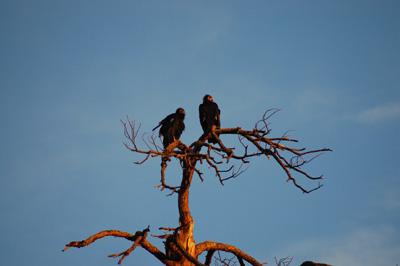If you like birding, are concerned about endangered species, and are free on Saturday, you're invited to see the release of four California condors into the wild at Vermilion Cliffs National Monument.
This national monument is managed by the U.S. Bureau of Land Management, not the National Park Service, but condors seem to like the nearby Grand Canyon National Park and could eventually end up there. Or, if you're lucky, you might spy one in the southern end of Glen Canyon National Recreation Area.
Saturday's release is the 14th annual. It is scheduled to take place at 11 a.m.
"It’s always a thrill to add more individuals to this growing flock, as well as to see them producing young successfully on their own in the wild," says Chris Parish, condor field project supervisor with The Peregrine Fund, the group releasing the birds.
Of the birds to be released, one was hatched and reared at The Peregrine Fund’s World Center for Birds of Prey in Idaho, and the other three originated from the Oregon Zoo’s captive breeding program.
"Arizona is privileged to be home to one of only three wild California condor populations in the world, so residents and visitors to our state have a unique opportunity to watch this release," says Kathy Sullivan, a condor biologist with the Arizona Game and Fish Department. "The public gets really into the release, waiting for the birds to come out and trying to subliminally encourage them to take that first flight out of the holding pen."
Once numbering only 22 birds, 169 California condors now grace the skies of California, Mexico and Arizona. The original 22 birds were captured in the 1980s in an effort to save the species through captive breeding. Condors produced in captivity are now periodically released to help grow the wild populations.
Condors were added to the federal endangered species list in 1967. The condor is the largest flying land bird in North America. The birds can weigh up to 26 pounds and have a wingspan of up to 9 1/2 feet. Condors were first reintroduced into Arizona in 1996, and there are now 67 in the state. Visitors to the Grand Canyon area are often able to observe the birds during the spring and summer, and they can be seen at the Vermilion Cliffs during the winter.
Lead poisoning is the leading cause of death in condors and the main obstacle to a self-sustaining population in Arizona. Studies show that lead shot and bullet fragments found in game carcasses and gut piles are the main source of lead in condors.
The Arizona Game and Fish Department, and its partners the Arizona Deer Association, Arizona Elk Society, Arizona Antelope Foundation, Arizona Desert Bighorn Sheep Society, and the Arizona Chapter of the National Wild Turkey Federation, encourage hunters to continue their proud tradition of wildlife conservation by using non-lead ammunition in condor range (Game Management Units 9, 10, 12A/B, and 13A/B).
The department started offering free non-lead ammunition in 2005 to hunters drawn for hunts in the condor’s core range, which includes Game Management Units 12 A/B and 13A. Contacts made with hunters in the field show that 90 percent of hunters took measures in 2008 to reduce the amount of lead available to condors.
To view the condor release, drive north on Highway 89 out of Flagstaff. Turn left (west) onto Highway 89A toward Jacob Lake and the North Rim of the Grand Canyon. Drive about 25 miles past Marble Canyon until you turn right onto House Rock Valley Road (BLM Road 1065). Travel about three miles to a shaded viewing area on the right.
On top of the cliffs to your east will be the location where the condors are released. The release site is approximately one mile from the viewing point. Biologists will be on-site to answer questions and several spotting scopes will be available to the public, although participants are encouraged to bring their own binoculars or spotting scopes for better viewing. Pack cold weather clothing, drinks and sunscreen.
The release site at the Vermilion Cliffs National Monument features a new informational kiosk, shade structure and restroom built by the BLM.
The condor reintroduction in Arizona is a joint project of many partners, including Arizona Game and Fish Department, U.S. Fish and Wildlife Service, The Peregrine Fund, Bureau of Land Management, National Park Service, Kaibab National Forest and Utah Division of Wildlife Resources.
For more information on California condors, check out this site.




Comments
In Pinnacles National Monument, California, a number of condors were released in January and February and more are scheduled for this year. You can follow the program there on http://www.nps.gov/pinn/naturescience/updates.htm - the Pinnacles condors formed a joint population with those released at Big Sur, where the further release is halted because their holding pen was destroyed by a forest fire last year. All condors in the pen at the time of the fire could be moved to safety on time. You can find more about the Big Sur condors at this slightly outdated website: http://www.bigsurcalifornia.org/condors.html
The third population - beyond Arizona and Central California - is situated on the Californian/Mexican border. Unfortunatly I can't find a comprehensive website on the program there.